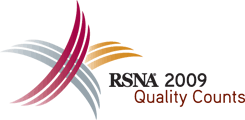
Abstract Archives of the RSNA, 2009
LL-IN2108-B07
caBIG™ Annotation and Image Markup (AIM) : A Ten Minutes Tutorial
Scientific Posters
Presented on November 29, 2009
Presented as part of LL-IN-B: Informatics
David Samuel Channin MD, Presenter: Officer, Hotlight, Inc
Shareholder, Hotlight, Inc
Daniel L. Rubin MD, Abstract Co-Author: Nothing to Disclose
Vladimir Kleper, Abstract Co-Author: Nothing to Disclose
Pattanasak Mongkolwat PhD, Abstract Co-Author: Nothing to Disclose
The purpose of this tutorial is to introduce the participant to the National Cancer Institute’s Annotation and Image Markup (AIM) project. The AIM project defines an information model and software tools to capture image annotation and markup using well defined common data elements and controlled terminologies. Understanding the caBIG™ AIM model and how to properly apply AIM in different scenarios is crucial to using AIM effectively. Examples of use cases are presented to demonstrate AIM in real world scenarios.
The AIM Model is represented using Unified Modeling Language (UML). The model consists of a set of classes organized into functional groups. These groups, their classes and the attributes of the classes will be reviewed along with the logic behind their design.
The participant in the tutorial will understand the overall organization of the AIM model and its classes. The participant will learn how AIM can be used in the real world and incorporated into clinical and research imaging software. AIM establishes a standard information model for annotation, markup and computational descriptions of image features. Well-defined terminologies such as DICOM, RadLex, SNOMED-CT and UMLS, are used to classify findings and can be placed in the AIM model.
The AIM model enhances interoperability between imaging and health information systems. Annotations stored in a computable model such as AIM can be queried not only to find images containing similar image content but to correlate human image observations with other biomedical data. This model can be used to create caBIG grid services or databases for the purposes of querying, retrieving and data mining AIM objects and related images.
This tutorial clarifies the distinction between the image annotations captured in free text radiology reports and those captured in a structured computable format based on controlled terminologies.
http://media.rsna.org/media/abstract/2009/8008214/8008214_xntj.jpg
Channin, D,
Rubin, D,
Kleper, V,
Mongkolwat, P,
caBIG™ Annotation and Image Markup (AIM) : A Ten Minutes Tutorial. Radiological Society of North America 2009 Scientific Assembly and Annual Meeting, November 29 - December 4, 2009 ,Chicago IL.
http://archive.rsna.org/2009/8008214.html

